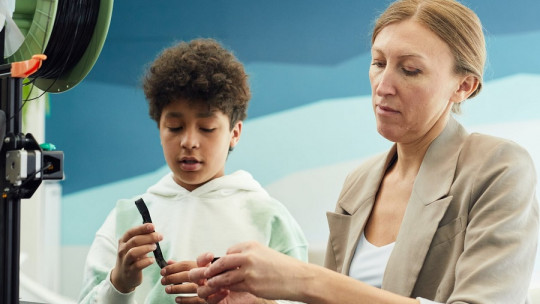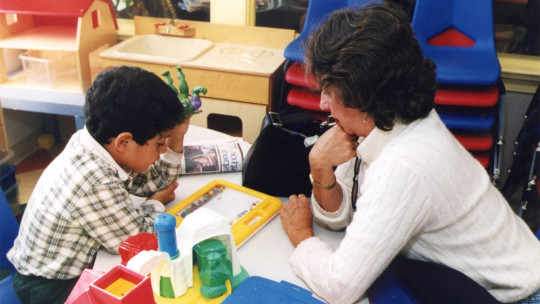
The postpartum stage of development is one of the most important and delicate periods in the life of every human being. We are born with certain neuronal and motor development, but neuronal connections and cortical circuits present their maximum expression between 8 months of gestation and 2 years of age. For example, the myelination process of the neurons of the nervous system responsible for the psychomotor process is not completed until 24 months of age.
Something similar happens with children’s learning and development. In short, the brain makes 1.8 million neuronal synapses between 2 months of gestation and 2 years of age, but in the years following this synaptic overproduction, a “selective pruning” typical of maturation occurs. It is also estimated that 83% of dendritic growth (neuron extensions) takes place in this stage of cerebral hyperexcitation.
As you can see, at birth the newborn perceives a new world, and experiences a process of nervous maturation impossible to achieve at other times in life. With special emphasis on the physiological phenomena that are taking place at this time, we present the current perspective of the neuropsychological evaluation of learning problems, especially in boys and girls
Bases of children’s neuropsychological development
First of all, we find it interesting to clarify some of the terms and figures already mentioned. Neuronal synapses are the contacts that neurons have between themselves or with another functional unit (muscle, for example), whose purpose is to transmit a message from one organ to another distant one. In general, neuronal synapses are produced by electrical potentials, based on cellular hyperpolarization and depolarization.
When a new activity is carried out, different synapses (or neural pathways) can be established. Since everything a newborn observes is new, Synapse production shoots up during the first years of life In any case, a subsequent “pruning” occurs, where excessive connections that are not useful are eliminated. On the other hand, when an activity or route is consulted very often, the synapses strengthen and mature, thus reinforcing functional connections. With these bases, the learning is briefly explained.
The evaluation of learning problems
The American Psychological Association uses the term Specific Learning Disorder or Specific Learning Disorder (ASD) to refer to learning problems as clinical entities This group includes those neurodevelopmental disorders that begin during childhood, although sometimes not detected until adulthood, which hinder individual functionality. In these patients, problems occur in three different areas: reading, writing or calculating, all of them essential pillars for the learning process.
An ASD can only be diagnosed once the learning process begins. According to the Diagnostic and Statistical Manual of Mental Disorders, For an infant to present one of these conditions, they must meet the following criteria:
So that, A specific learning disorder is only applied when there is no specific cause that explains it A person with Down syndrome or fragile Examples of ASDs are dyslexia, dysgraphia and dyscalculia, for example.

The neuropsychology of learning disabilities
In the last 30 years, special emphasis has been placed on addressing children’s learning problems from an interdisciplinary point of view. Neither the entire clinical picture lies in the child’s genes nor is the environment the only trigger To integrate all these frameworks, different categories of approaches have been proposed.
In the first “step” of the learning problem we have the neurobiological bases, which include genetic factors and the nature of the brain and its functionality For example, the connection of the auditory cortex with the high-level processors of the inferior frontal gyrus is weakened in people with dyslexia, something that could explain, in part, the onset of their condition. Furthermore, about 40% of the siblings of a dyslexic patient also have it: it is clear that genetic inheritance plays an essential role in learning problems.
In the second step we have cognitive processes, that is, those that allow us to process information from perception, acquired knowledge (experience) and the set of subjective characteristics that allow the information to be evaluated. Cognition is strongly associated with many other abstract mental processes, such as the mind, perception, reasoning, intelligence, learning, and many others.
If we move away from the baseline physiological and neurological conditions of the infant, we will see that the next category is psychological factors. A child with chronic anxiety or depression has difficulty learning, since its altered hormonal circuits do not allow the body to integrate information as it should, due to a continuous state of alert. These altered states (short and long term) must be taken into account to explain the dynamics of learning problems.
Ultimately, and for clinical packaging, we have to environmental factors The socioeconomic status of the family, the type of school the child attends, the education and many other parameters can balance the balance. These are not the absolute cause of ASD, but they can promote its manifestation and make the symptoms more or less evident.
Summary
As you can see, learning disabilities must be conceived as an interdisciplinary network, not only as a product of the patient’s brain or as a consequence of an environmental stressor. It is necessary to take into account each of these “layers” to find the appropriate treatment in each case. In any case, at the first signs that a boy or girl has learning problems, It is important to seek professional help as soon as possible








